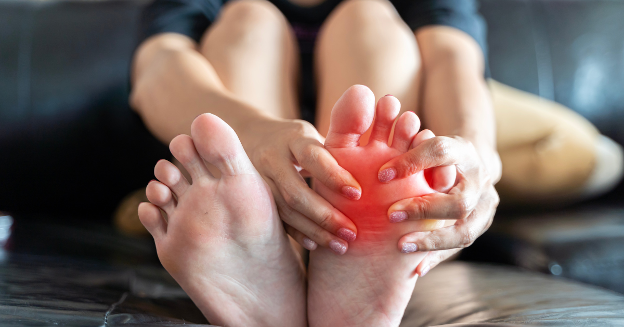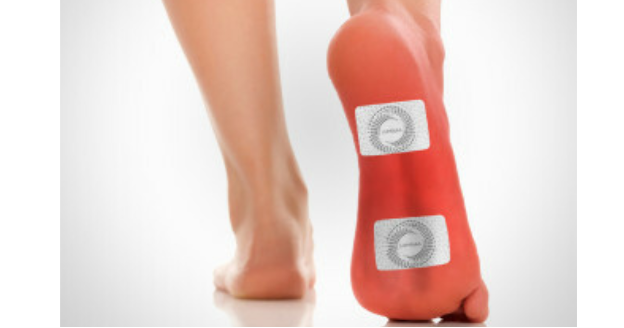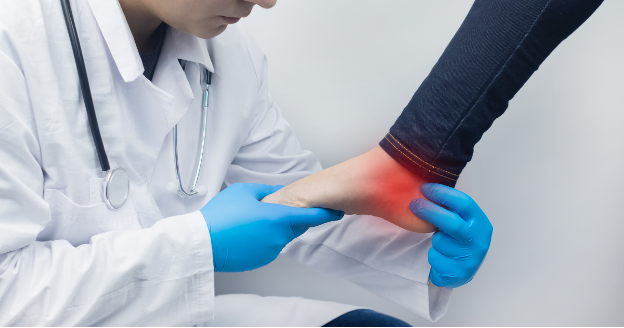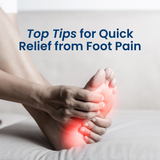Quick Relief for Pain on the Bottom of Your Foot: 5 Tips You Haven’t Tried Yet
Key Takeaways
Identify the Cause: Foot pain can occur in different areas—near the toes, in the arch, or around the heel. Common causes include metatarsalgia, plantar fasciitis, heel spurs, and stress fractures.
LUMINAS Foot Pain Relief Patches: Our patches offer fast, targeted relief by reducing pain and inflammation, especially for conditions like plantar fasciitis and heel spurs.
Explore Effective Remedies: There are several proven ways to relieve foot pain that don’t involve traditional remedies. These methods target both pain and inflammation at the source, helping you recover faster.
When to See a Foot Specialist: If your pain persists, is severe, or involves swelling or a potential injury, consult a healthcare provider for further evaluation.

Why does the bottom of my foot hurt when I walk? If you’ve ever asked yourself this question, you know how frustrating and painful it can be. Whether it’s a dull ache or a sharp sting, foot pain can make even the simplest tasks uncomfortable.
At LUMINAS, we understand how important it is to keep moving pain-free, so before you reach for the usual remedies, let’s explore five easy tips that could give you the relief you’ve been searching for. These aren’t the same old ideas—you’ll be surprised how effective they can be to ease foot pain!
What Can Cause Pain on the Bottom of Your Foot?
The location of your foot pain can tell you a lot about what’s going on. Let’s break it down by where you’re feeling the discomfort—near your toes, in the middle (your arch), or around the heel bone.
Pain Near the Toes
Metatarsalgia (Pain in the Ball of the Foot): Metatarsalgia is caused by too much pressure on the metatarsal bones, ill-fitting shoes, high heels, or standing for long periods. It’s common for people who engage in high-impact sports like running.
Morton’s Neuroma: If you feel burning pain or tingling between your toes, it could be Morton’s neuroma. This happens when the nerve between the toes thickens, usually because of tight shoes or a narrow toe box.
Plantar Warts: These viral growths near the toes can cause discomfort when walking or standing, and the pain often feels like stepping on a small pebble.
Pain in the Middle of the Foot (Arch Area)
Plantar Fasciitis: Plantar Fasciitis is one of the most common causes of foot pain, especially in the arch. The plantar fascia, a thick band of tissue, can become inflamed, causing pain that’s often worse in the morning.
Adult Pes Planus: People with flat feet or fallen arches, often experience pain in the middle of the foot because their feet lack proper support, putting strain on the soft tissues.
Stress Fractures: Repetitive activities, such as long-distance running or spending long hours on your feet, can cause tiny fractures in the metatarsal bones, leading to persistent foot pain.
Pain Near the Heel
Heel Spurs: These are small, bony outgrowths on the heel bone that can cause foot pain when walking or standing, especially if you’ve been on hard surfaces for too long.
Plantar Fasciitis: Along with the arch, this condition can also cause stabbing heel pain, particularly with the first steps of the day.
Tight Achilles Tendon: If your Achilles tendon is tight, it can pull on the heel, causing discomfort, especially after exercise or standing for too long.
How to Relieve Bottom of Foot Pain
Now that we’ve covered the most common causes of pain on the bottom of the foot, let’s dive into five practical tips that will help you get back on your feet pain-free!
1. Stick It to Foot Pain with LUMINAS Foot Pain Relief Patches
If you’re dealing with foot problems and want fast relief, consider trying a LUMINAS Foot Pain Relief Patch. Our innovative patches are designed to target pain and inflammation at the source without needing creams or medication. They can be especially helpful for issues like plantar fasciitis, heel spurs, and even stress fractures.
Just apply 1-2 patches to the painful area and let it work its magic. The best part? It’s easy to use and works whether you’re at home or on the go.

2. Soothe Your Soles with Reflexology
Did you know your feet are packed with pressure points that connect to different parts of your body? With foot reflexology, you can target those points to reduce tension and improve blood circulation. This technique is great for alleviating heel pain, relaxing your Achilles tendon, and even soothing tight calf muscles.
Here’s a simple way to try reflexology at home:
- Use your thumb to press gently on the ball of your foot.
- Move to the arch, applying light pressure in small circular motions.
- Finally, massage the heel for 1-2 minutes to help with pain in the bottom of your foot.
This easy routine can bring you relief after a long day on your feet.
3. Give Your Toes Some Space with Toe Separators
If you suffer from flat feet or wear shoes that are narrow, your toes might need some room to breathe. That’s where toe separators come in. These small, soft devices fit between your toes and help realign them, relieving pressure on the metatarsal bones and easing discomfort in the bottom of the foot.
Using toe separators while relaxing at home is a simple way to let your feet recover. They’re especially helpful if you’ve been wearing shoes with a narrow toe box or shoes without good arch support.
4. Revive Your Feet with a Healing Soak
There’s nothing like a warm foot soak to melt away the day’s aches and pains, but did you know it can also help treat foot pain? A soak with Epsom salt and apple cider vinegar can reduce inflammation and relax the soft tissues in your feet. It’s especially useful for conditions like heel spurs or plantar warts.
Here’s an easy recipe for a relaxing foot soak:
- Fill a tub with warm water.
- Add 1/2 cup of Epsom salt and 1/4 cup of apple cider vinegar.
- Soak your feet for 15-20 minutes, letting the warmth and salt ease the tension in your muscles.
Bonus tip: Add a few drops of lavender essential oil for an extra touch of relaxation!
5. Cool and Roll: The Water Bottle Trick for Pain Relief
Here’s a simple yet effective trick: take a frozen water bottle, place it on the floor, and roll the bottom of your foot over it. The cold helps reduce inflammation while the rolling motion provides a gentle massage, making it perfect for relieving plantar fasciitis pain or a tight Achilles tendon.
How to do it:
- Freeze a bottle of water.
- Sit down, place the bottle on the floor, and roll your foot over it for about 10 minutes.
Try doing this once a day to reduce pain and give your feet a much-needed break, especially after a long day of walking or wearing shoes.
When Should You See a Healthcare Provider?
While at-home treatments can be helpful, there are times when it’s important to consult a foot specialist. If your foot pain persists despite trying these remedies, or if it’s accompanied by severe pain, swelling, or a possible broken bone, it’s time to seek professional help.
Here are signs you should see a foot specialist:
- Severe foot pain that doesn’t improve with rest or over-the-counter remedies.
- Foot pain that interferes with daily activities like walking or standing for long periods.
- Pain accompanied by swelling, redness, or changes in skin color, which could indicate an infection.
- Sudden pain after an injury, as this might suggest a broken bone or stress fracture.
- Chronic conditions like plantar fasciitis, heel spurs, or rheumatoid arthritis that aren’t responding to at-home treatments.
A foot specialist can perform a thorough physical exam, order imaging tests like X-rays, and recommend more advanced treatments such as physical therapy, custom orthotics, or even foot surgery if necessary.

The Bottom Line: You Can Relieve Foot Pain
Dealing with foot pain, especially on the bottom of your foot, can be frustrating—but you don’t have to live with it! These five simple tips—whether you’re using LUMINAS Foot Pain Relief Patches, massaging your feet, or trying a soothing soak—can help you find the relief you need.
It’s time to take the next step toward easing foot pain and getting back to what you love, pain-free.
Try LUMINAS Foot Pain Relief Patches today for fast, targeted relief without the need for medication.









